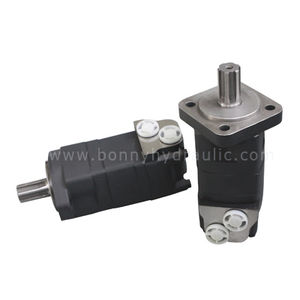
- Power Transmission - Mechanical components
- Motor and Motor Control
- Piston hydraulic motor
- Ningbo Bonny Hydraulics Transmission Co., Ltd.
- Products
- Catalogs
- News & Trends
- Exhibitions
Piston hydraulic motor NAM2 Seriesindustrial

Add to favorites
Compare this product
Characteristics
- Technology
- piston
- Other characteristics
- industrial
- Pressure
Min.: 0 bar
(0 psi)160 bar, 200 bar, 250 bar
(2,321 psi, 2,901 psi, 3,626 psi)Max.: 320 bar
(4,641 psi)- Rotational speed
Min.: 8 rpm
(50.27 rad.min-1)Max.: 1,250 rpm
(7,853.98 rad.min-1)- Torque
Min.: 935 Nm
(689.62 ft.lb)Max.: 36,667 Nm
(27,044.19 ft.lb)- Displacement
Min.: 213 ml
(7.2 US fl oz)Max.: 10,019 ml
(338.78 US fl oz)
Description
Model
NAM2 Series
Replace for
Hagglund NHM2 Series,
Denison, Intermot
Displacement
213-10019 ml/r
Torque
935-36667 N.m
NAM series bent axle connecting rod type motor has such characteristics as: high mechanical efficiency and good reliability, thus it can be widely applied in hydraulic and transmission systems of plastics machinery, light industrial machinery, heavy type metallurgical machinery, petroleum and coal mining machinery, lifting and transportation equipment, ship's deck machinery, geological prospecting equipments, etc.
Features:
As the product adopts eccentric crankshaft and five-piston structure with comparatively low frequency, it has low noise characteristic;
It has big startup torque, perfect stability at low speed, so it can stably operate at very low speed.
The patented plane compensation port plate has perfect reliability and almost no leakage. The piston bushing is sealed by seal ring, so it has comparatively high volume efficiency.
The crankshaft and the connecting rod are supported by roller, so it has very high mechanical efficiency;
The rotational direction is reversible, the output shaft allows endure certain radial and axial force;
It has comparatively high power mass ratio.
Other Ningbo Bonny Hydraulics Transmission Co., Ltd. products
Hydraulic Motor
*Prices are pre-tax. They exclude delivery charges and customs duties and do not include additional charges for installation or activation options. Prices are indicative only and may vary by country, with changes to the cost of raw materials and exchange rates.




















